Great post, Tom! I love the term ‘coursels’! I’ve used this type of course development approach in creating software tutorials – at the end of the day, all ‘coursels’ are typically boxed up with the software as a larger being, but the user is able to select these bite sized learning objects or delve deeper into the larger being – whichever they choose!
Instructional Design Challenges for Today’s Course Designer
April 15th, 2014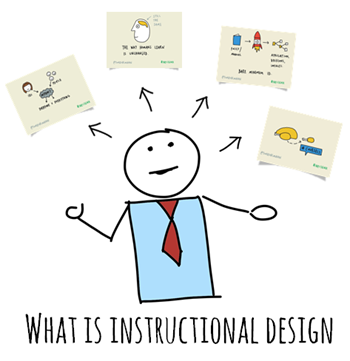
At the iDesignX conference in Australia I shared some tips on instructional design challenges. During my session, Blair Rorani from Ever Learning sketched his notes and then tweeted them during the session. They’re so cool I couldn’t just let them fade away.
So here are Blair’s sketches coupled with some quick notes from my presentation on instructional design challenges.
What is Instructional Design?
Instructional design is a loaded term and can mean many things depending on who’s doing the talking. In today’s elearning world an instructional designer tends to be synonymous with the person who builds elearning courses.
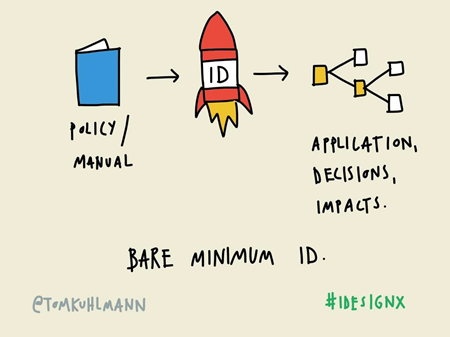
In a general sense an instructional designer helps craft the appropriate learning experience whether they actually build the course or not. As the instructional designer, you want the learner to acquire information in a context that is relevant and have them make the types of decisions that are similar to what they’d do outside of the learning environment.
Know that Learning Happens Despite Instructional Design
When I used to train instructional designers I always started with “learning happens” as a reminder that people learn regardless of what we do. And in many cases, we could be interfering with how they’d learn if we don’t do it right.
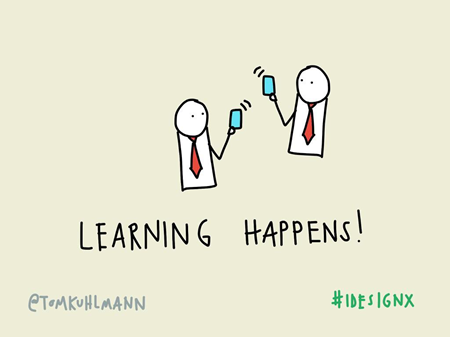
It’s important to keep this in mind as we design our courses. People aren’t just sitting around like empty pitchers of water waiting for us to fill them. They’re continually filling the pitcher themselves and we’re just one of the options they have as they learn.
Instructional Design Changes with Technology But….
Our industry has evolved quite a bit. And every day there’s some new technology to assist with learning. This can cause quite a bit of anxiety as we are stuck building boring click-and-read PowerPoint courses and feel the world passing us by. How do we keep up with it all?
Twenty years ago, as a young videographer I felt the same way. Video was going from analog to digital and I thought I’d never keep up. The other thing I thought twenty years ago was that someone would realize how easy this PowerPoint stuff is and I’d be out of work.
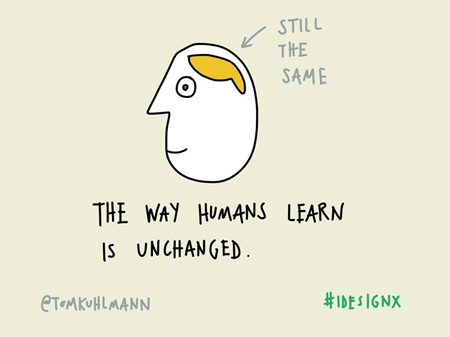
Guess what?!? Not that much has changed. After twenty-five years, PowerPoint is still a means of gainful employment. And while new technology has influenced the learning process, how people learn hasn’t changed much. Sure, we have all sorts of new ways to create, curate, access information and connect with people, but the innate way we learn isn’t much different. Generally speaking we get new information, process it, and make it part of our memory. We just have different ways to do that.
Instructional Design Faces New Challenges
Years ago, formal training created constraints and limited access to information. In a sense, instructional designers and trainers were firewalls to acquiring information. It wasn’t as easily available then as it is now. Today there are all sorts of access to expertise and the tools needed to learn.
For example, I needed to repair all of the locks in my home recently. In the past I was dependent on a trained lock smith to do the repairs. Today that’s not the case. I was able to go online and find some videos that showed me how to do what I needed to do. I was taught at my point of need.
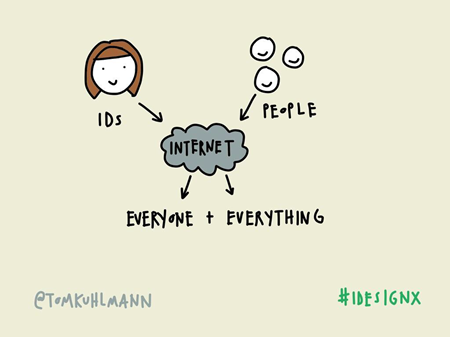
Am I now a lock smith? No. But I am trained to do what I needed to do and didn’t need to participate in a formal training program to learn it.
If a corporate training group wanted to teach me the same thing, I would have learned about the history of locks, types of locks, and how locks worked. I may have even been given the steps to make the repairs. And if I was lucky, I would have had some time to practice repairing the locks as part of the training. And it would have taken 90 days to get that training built.
The point is that we are no longer the gate keepers of information and training. Technology has empowered people to find information and connect with others to learn in all sorts of ways. Let’s embrace that and leverage this to craft more efficient and effective instructional design.
Instructional Design Embraces Bite-sized Learning
Building off the point above, instead of building large formal programs, try building smaller chunks of learning. I like to call them coursels, as in course morsels.
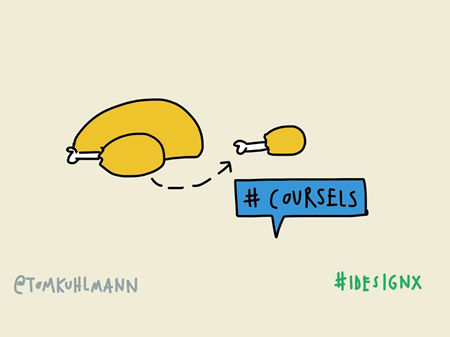
They’re smaller nuggets of learning that offer the flexibility larger programs don’t. They can be built faster and at lower cost. They’re great for those just-in-time training needs and easily shared. And they can be packaged into larger, more detailed training if needed.
Another advantage is that people tend to be more tolerant of lower quality if the coursel is relevant and helpful. They also tend to share the smaller nuggets more that large courses. So there’s a good chance the learning resources is passed around. The smaller nuggets are also effective for spacing the learning activities over time rather than having everything compressed into a single learning event.
And there you have it, the essence of my thoughts on instructional design. As I noted above, instructional design is loaded with lots of meaning and different definitions so there are many perspectives to consider. There’s obviously a lot more to it than what I shared and more to discuss regarding each topic on which I touched.
What are your thoughts on instructional design? What are you biggest challenges?
Events
- Everyday. Check out the weekly training webinars to learn more about Rise, Storyline, and instructional design.
Free E-Learning Resources
 |
 |
 |
|
Want to learn more? Check out these articles and free resources in the community. |
Here’s a great job board for e-learning, instructional design, and training jobs |
Participate in the weekly e-learning challenges to sharpen your skills |
 |
 |
 |
|
Get your free PowerPoint templates and free graphics & stock images. |
Lots of cool e-learning examples to check out and find inspiration. |
Getting Started? This e-learning 101 series and the free e-books will help. |
18 responses to “Instructional Design Challenges for Today’s Course Designer”
This blog post is rather timely. I was just thinking that the term “instructional designer” is used somewhat haphazardly in the field. The literature describes instructional design as a process for solving ill-structured problems related to changing a person’s KSAs. I’ve worked in several industries in different roles, and the roles titled “instructional designer” actually required less of my problem solving capabilities than those roles with non-ISD specific titles. Instead, I found myself working as project manager or a content writer. One colleague mentioned to me that he thinks there is a difference between an instructional designer and an instructional systems designer… where the first is more focused on content development and the latter is focused on designing the solution (which of course isn’t limited to just the training intervention). I thought that was interesting, and also a reflection of how our identity as instructional designers seems to mean something different to everyone.
Great ideas! I love thinking about “interactivity” as utilizing resources available outside an eLearning course. Have the user bring to the learning things they can find from other places. They probably didn’t realize they were learning!
Appreciate your article! Some comments:
“As the instructional designer, you want the learner to acquire information in a context that is relevant and have them make the types of decisions that are similar to what they’d do outside of the learning environment.”
Indeed, as this provides an occasion for the effective generalization of the new concepts/skills learned. Interestingly, as far as we know, hunter/gatherer bands provided similar learning environments for their young–including crafting miniature tools similar or identical to those used by adults (except for very dangerous items, such as poison darts). Perhaps this design model formalizes and leverages something innate within us which facilitates sharing ‘culture.’
“I like to call them coursels, as in course morsels.”
Now, why did I first read “coursels” as “corsets?” Well, given its Wikipedia df. as “a garment worn to hold and shape the torso into a desired shape,” perhaps a ‘coursel’ helps to shape a learner’s ‘cognitive body’ toward a desired end. I know…it’s a stretch… 😉
‘Courselizing’ content provides a good cognitive advantage for the assimilation and integration of new concepts/skills. Additionally, in the US, the Americans with Disabilities Act (ADA) mandates accessibility, and modularizing the content assists individual with cognitive impairments (even while helping those without), thus meeting the ADA mandate.
“The point is that we are no longer the gate keepers of information and training.”
This is an excellent point. However, given a specific subject area or skill set, we can envision learners somewhere on a learning continuum where the endpoints are “heteronomous learning” (other-directed) and “autonomous learning” (self-directed). With this in mind, perhaps a ‘coursel’ could contain design elements (methods/materials) which meet the learning needs across this continuum–with the thought of nurturing “autonomous learning.” Doing this supports the concept of Universal Design for Learning (UDL).
Well done and thank you.
–Gary
My team develops training (classroom, live web, and elearning) for our external customers — mostly software product training. Our issue is we’re a profit center and are more successful selling larger classes than small mini-tutorials. We don’t want to charge our customers small amounts for access to the shorter material — seems like a lot of “nickel & dime”-ing. We’ve been considering a subscription pricing model to give them access to lots of modular elearning, but that proposal is a mixed bag on how it’s being received by customers. We’re constantly dealing with designing free content vs paid content.
Thanks for sharing these insights Tom.,
At the moment I’m busy with breaking the whole curriculum of basic arithmetics into small pieces. By doing this I want the learners to be able to only choose the parts of the curriculum that they really need. But also from a marketing point of view it is a great idea of breaking up your ‘course’ into smaller pieces.You can share some of the smaller pieces for free with potential learners and only charge them when they want to take the whole course.
Thanks!
Griddle posts???! I waffle on their use… 🙂
Seriously, I’d like to know your ideas about this, and am looking forward to you sharing those.
–Gary
ps Corsets “tie in?” No pun intended by you, of course… Greatly appreciate your blog!
Your comment that “Learning Happens” sometimes despite ID, made me think of an incident I experienced volunteering for children’s church.
This particular day the lesson was on coveting. I read the definition provided, and asked if they understood. They shook their heads. I attempted to tell them a story to make the concept more understandable.
I said, “Imagine you and your brother are both given a piece of candy by your mom, and you eat your candy right away, but your brother puts his on the kitchen counter and goes out to play. You are standing in the kitchen, alone, with your brother’s piece of candy. You know it is not yours, and you should not take it, but inside you want to take it and eat it too. Coveting is wanting something that does not belong to you.”
We did the rest of the lesson, related arts and crafts project, sang a song, and then they played. Before their parents came for them, I asked if they could tell me what they learned today about coveting.
Little Sarah Burke, who had an older brother, raised her hand and confidently said, “Eat your candy before you go outside!”
“Close enough”, I thought, trying to suppress my laughter.
Sometimes what we intend, is not exactly what is learned. You are right, learning happens, sometimes in spite of ID.
@NMN: Yours is a great story! I like the example you provided to the children–very creative and quite authentic. Well done! Sarah evidenced that she was, in fact, listening to your story, and took a good lesson from it, from her perspective.
This reminds me of the oft-retold story of the men who are blind and an elephant. Your “coveting” example painted (conjured) an ‘elephant’ for the children, and Sarah recalled a part of that ‘elephant’ that she could conceptually reach…
Great article, Tom
How about a post on how to build effective coursels?
Just my 2 cents
I really like the idea of coursels. One of the potential benefits of elearning is the ability to tailor courses for individuals and by organising courses into manageable chunks of learning we enable learners to choose their learning. Some learners are good at selecting which coursels are of most benefit to them. Another way of helping learners with these choices is to combine the elearning plan with performance review, this has the added benefit of checking back as to whether the education has been effective; much better than a contrives assessment on-line. If managers are able to provide the learner with a mentor for their learners in the workplace we are on to a winner!
Great post Tom and really love Blair’s sketches.
thanks for your valuable posting, it was very informative i am working in Erp in Chennai
Thanks for the post Tom. Like Heather, I am in a model where we are a profit center and develop “full day onsite courses” for hardware and software training. Because each customer installation is unique, I do not build huge PowerPoint decks or student manuals for my classes. Instead spend 95% of the training class doing live demos of how to use the hardware & software they purchased. While the students love this approach, the deficiency is they cannot remember everything we cover. So, I created a set of “help modules” for best practices as well as the most common tasks they will encounter. I provide the links to the modules as part of the training delivery.
I LOVE the idea of “coursels”. I’m in the process of breaking a structured, face-to-face Ph.D down into these bitesize pieces so it can be blended.
We’ve been calling them “sessions” and “lesson segments” and RLU’s (Resuable Learning Units – a term that I’ve seen in the literature) but “coursels” is so much more creative.
Great post Tom! Great idea!
I liked this so much I’m sharing it with my colleagues at work.
A related thought (sometimes it seems like the only one I raise) is Joe Harless’s: the question for any instructional designer is not “what do people need to know?” but “what do people need to do?”
That’s a crucial point of view, because it opens possibilities other than the formal, full-blown training course. Can we help people to do X by courslets? Through job aids? Through short, task-relevant demos (which are what Ruth Colvin Clark calls worked examples)?
This point of view is also a good antidote for feature-philia, which tends to strike people who get to a certain level of skill with any tool. “Ooo, this is a cool effect” by itself is rarely a good instructional design decision. 😉



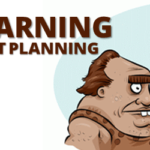





0
comments